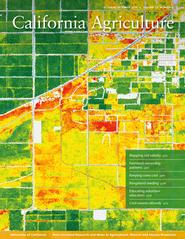All Issues

Scudiero et al. used satellite imagery to model root-zone soil salinity in the western San Joaquin Valley. They found 30% of mapped farmland to be strongly or extremely saline. In the map section shown on the cover, soil salinity ranges from non-saline (dark green) to extremely saline (red). Image credit: USDA-ARS and University of California Riverside.
Editor Jim Downing talks about what's in the current issue of California Agriculture journal — mapping soil salinity by satellite; evaluating crop ownership patterns in California; growing oilseeds in winter without irrigation; seeding rangelands; keeping dairy cows cool; and pedagogical lessons for volunteer educators.
Volume 71, Number 4
News and opinion
UC ANR is a network of change agents who care about the health and welfare of people, communities and natural resources.
A survey of UC ANR academics found opportunities for expanding the role of climate change in extension work.
Located in the Imperial Valley, this research station runs UC ANR's biggest agricultural outreach program and hosts the largest public carrot breeding program in the Americas.
Recent scientific articles from the Agricultural Experiment Station campuses.
Steven Worker is helping to improve out-of-school-time pedagogy.





